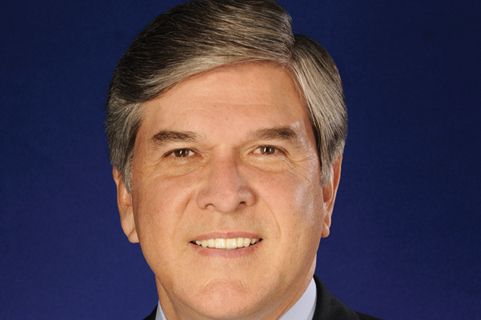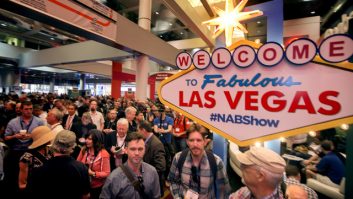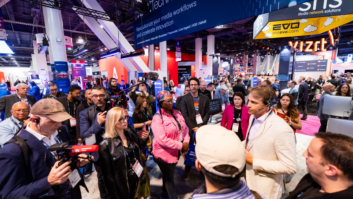
Written by NAB president and CEO, Gordon Smith exclusively for TVBEurope
Monumental. Historic. Jaw-dropping. Those are just a few adjectives that describe the tsunami-like disruption occurring in today’s media delivery landscape. Every day brings a breathless press release announcing a new app, a new IPO and a new OTT service destined to destroy ‘traditional’ TV.
Indeed, broadcast TV faces competitive challenges the likes of which our business has never seen. But make no mistake: Local TV stations – in partnership with broadcast networks – are the King Kong of TV content, delivering millions of viewers each and every day as the US’ premier video entertainment option.
Broadcast television remains the most-watched entertainment programming, from Empire to Modern Family to Big Bang Theory to The Voice. We are the most-reliable source for local news, weather, sports, public affairs and emergency information programming. We are home to over 90 of the top-100 rated programmes during primetime, as well as ‘must-see’ marquee programming such as the Super Bowl, the Oscars and the Olympics.
Broadcast TV is also the only video service that is free and locally based. Local TV stations are in every corner of the country providing a necessary public service to communities. When disaster strikes, it is broadcasters who are in the field with boots on the ground reporting before, during and after the disaster. We are devoted to investigative journalism, serving as a watchdog on corrupt government officials and shady local businesses.
We live and work in the communities we cover. So it’s no wonder it’s the local TV station that sheds light on City Hall scandals from Flint, Michigan to Missoula, Montana. Somewhere in the US – on each and every day – a local TV station is raising funds for a local charity, collecting food or clothing for neighbours in need, or devoting free air time to promote education and healthy lifestyles. Being a good corporate citizen is in the DNA of the local broadcaster.
And right now, working with the Partnership for Drug Free Kids, broadcasters across the US are running PSAs, airing town hall meetings and using our social media platforms to fight opioid and heroin addiction, an epidemic that is ravaging so many communities and families.
During this election year, local TV stations worked to ensure voters could make informed choices when they went to the polls. Local TV stations aired countless debates between candidates running for federal, state and local office. We sponsored voter registration drives to help citizens make their voices heard. Broadcasters spent newscasts, town halls and specials delving into the national and local issues facing voters. Our commitment to serving the public good is a reason the most civically engaged citizens tune into local TV to stay informed about their communities, according to a recent survey.
Yet, despite these successes, broadcasters are not resting on their laurels. We know we face stiff competition as viewers increasingly go online to watch their favourite shows or turn to smartphones and mobile devices for entertainment or information. That’s why broadcast networks have invested in Hulu and CBS All Access, and it’s why local TV stations often host the most populated websites in any given market.
Perhaps the broadcast innovation with the most potential to shake up the video landscape is the development of a new broadcast transmission standard. For the past several years, the Advanced Television Systems Committee (ATSC) – a cooperative effort between broadcast, consumer electronics, cable, satellite, motion picture and computer industries – has been working on a new IP-based transmission standard called ATSC 3.0, also known as next-gen TV. This new transmission standard combines the advantages of broadband and broadcast to transform the way we deliver mobile, interactivity and higher quality content – all available to consumers for free.
At the 2016 NAB Show last April, broadcasters highlighted just some of the potential advances made possible by next-gen TV. NAB broadcast live content from the show floor to the pavilion to demonstrate the standard’s support of UHD that provides a richer picture quality, HDR that offers a greater accuracy of colours, and wide colour gamut that shows a broader spectrum of colours. Because the new standard makes more efficient use of spectrum, broadcasters could have the chance to offer these features on not just their main programming stream but on multicast channels offering a diversity of programming.
The standard’s use of an IP-based backbone also enables interactivity for consumers, which could also provide broadcasters with new revenue streams. A viewer might be able to shuffle through different camera angles while watching a football game, or even click on an advertisement and be taken to that company’s website where they could shop.
Next-gen TV is also designed with built-in native mobility from the very beginning, and was engineered to serve devices in motion. Viewers would be able to access their local broadcast channels on their phones, tablets, or even in cars, subways and trains.
Already we are seeing broadcasters making progress in deploying the new standard. In June, Capitol Broadcasting’s WRAL-TV in Raleigh-Durham, N.C. became the first commercially licensed station to begin broadcasting using the new standard. In October, Tribune Broadcasting’s WJW-TV in Cleveland delivered the first live broadcast of a major professional sporting event in next-gen TV: game two of the World Series.
Sports will continue to help lead the charge towards widespread option of next-gen TV. In South Korea, there is a mandate to broadcast the 2018 Winter Olympics in UHD. Korean-based TV manufacturers, including the world’s two biggest in LG and Samsung, will be unveiling new TVs equipped with next-gen TV reception next year in anticipation of these broadcasts. These sets should soon be available in the US as well.
Despite the progress made by broadcasters on next-gen TV, we still need action from the FCC. We need the FCC to bless this standard before we can begin innovating with it.
In April of last year, NAB partnered with the Consumer Technology Association (CTA), America’s Public Television Stations (APTS) and the Advanced Warning and Response Network (AWARN) Alliance to ask the FCC to begin the process of allowing local TV stations and TV receiver manufacturers to implement next-gen TV on a voluntary, market-driven basis. NAB hopes the FCC will issue a rulemaking by the end of the year so consumers can begin to enjoy the potential benefits of next-gen TV.
From a public safety perspective alone, the FCC should move swiftly on our petition. Next-gen TV has the potential to save countless lives through advanced emergency alerting features that are broadcast to not just TVs but also smartphones and tablets and other mobile devices. The standard allows broadcasters to ‘wake up’ devices in given areas with emergency alerts when danger is near. For example, a family at home in the path of an approaching tornado could be woken up in the middle of the night by a tablet turning on and alerting them to ‘seek shelter immediately’. The standard also allows broadcasters to provide multimedia content, which could be used during emergencies to send evacuation maps, videos, pictures, and other content to help keep people out of harm’s way.
For decades, local broadcast television has remained at the forefront of Americans’ lives because of our high-quality content, community service and dedication to keeping viewers informed about the world around them. That was no exception in 2016. Yet, broadcasters know that we must continue to push forward with new and innovative content to keep the attention of the public. A new broadcast standard can help us achieve our goals. We strongly urge the FCC to join us and help implement next-gen TV to the benefit of all Americans.






